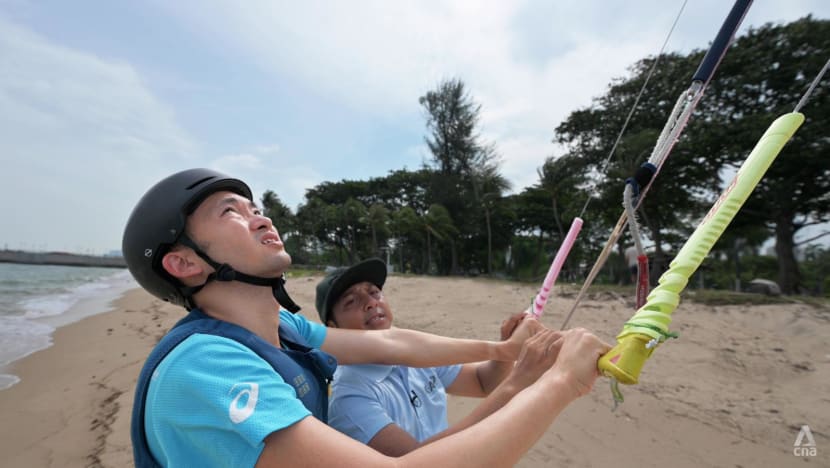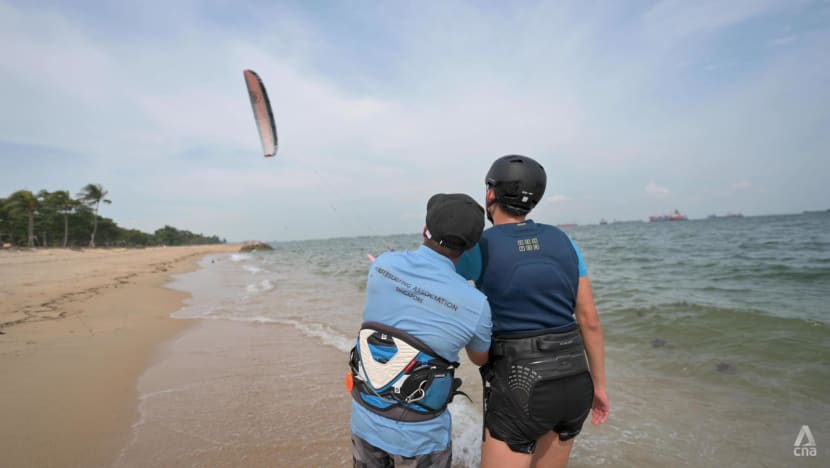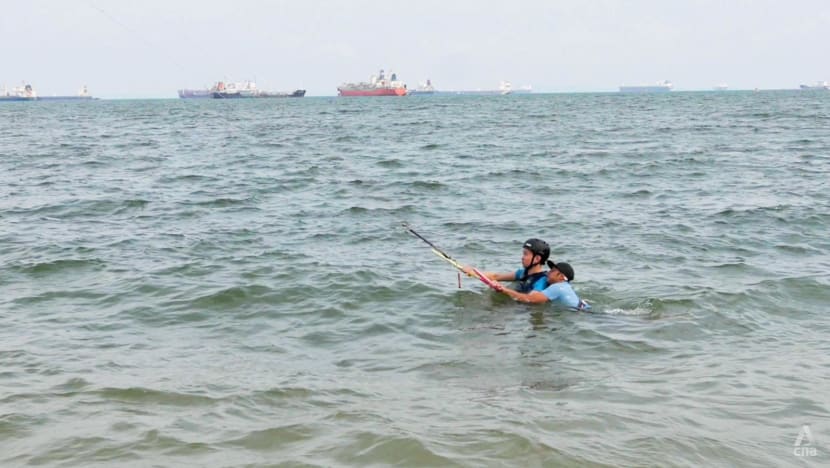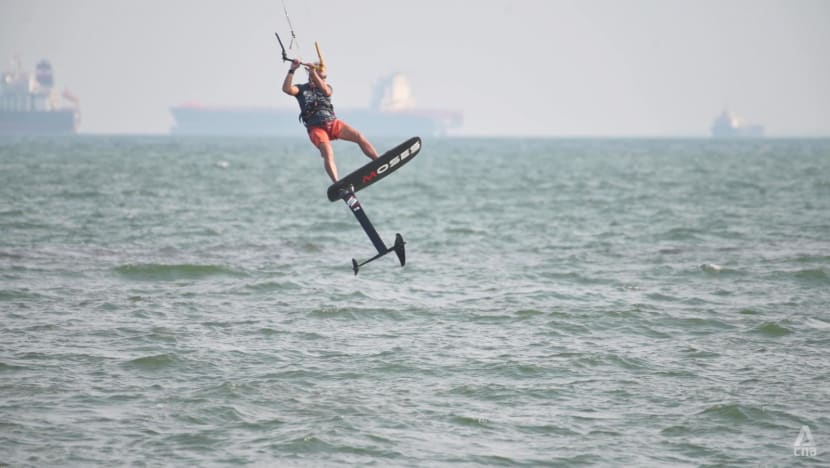What is kitefoiling, the sport done by Singapore's Olympic medal hope Max Maeder – and just how hard is it?
CNA journalist Justin Ong gives the high-speed water sport a try.

Kitefoiling instructor Harun Talikov showing CNA journalist Justin Ong how to control a kitefoiling kite at East Coast Park. (Photo: CNA/Raydza Rahman)

This audio is generated by an AI tool.
SINGAPORE: I drifted a few metres from shore, waves slapping my face as I swallowed mouthfuls of seawater, neck aching beyond imagination as I was reminded - for the fiftieth time - to keep my eyes on the parachute-like contraption I was snugly harnessed to.
Then the "kite", as they call it, caught the wind at a precise angle and just like that, I was getting pulled along in the water.
“You control the kite, the kite does not control you!”
I had no idea what the instructor meant – just like I had never heard of the sport of kitefoiling, until the recent emergence of Singaporean Maximilian Maeder.
Last August, as a 16-year-old, he was crowned world champion in the men's kite event; and successfully defended his title in May this year. Not for no reason is Maeder being touted as Singapore's strongest medal hope at the coming Paris Olympics.
Videos of the teenager in action show him gliding along on a board that appears to float above the water, making the sport look almost as easy as riding a bicycle.
But is it, really?
An introduction to kitefoiling
Kitefoiling is a style of kitesurfing or kiteboarding, which are essentially sports using wind power from a kite to pull a rider along.
Kitesurfing is believed to have been invented in the 1970s, but it was only in the 1990s that it gained popularity, with the first competition held in Hawaii in 1998.
In 2008, the International Kiteboarding Association was founded. The sport then appeared at the 2018 Youth Olympic Games.
Three years later, it was announced that kiteboarding will make its Olympic Games debut in Paris 2024, in the Formula Kite class which features a hydrofoil board.
Compared to typical boards which keep contact with the water's surface, the wing-like hydrofoil can lift the rider up – reducing drag, providing faster speeds and increasing manoeuvrability.
Because of this, riders appear to "fly" above the waves, and can reach speeds of up to 70kmh.
"I FEARED I WOULD BE BLOWN AWAY"
To learn kitefoiling, I first had to find a day with enough wind – ideally 18kmh. And I was put on standby on three occasions, only for plans to be cancelled due to a lack of draught.
The stars finally aligned on the fourth attempt, and Harun Talikov, vice-president of the Kitesurfing Association of Singapore, was on hand to teach me the basics.
It began with a crash course on handling the 10m-long kite, while on dry land. This is done using a bar - which, in fact, looked like bicycle handlebars - to steer the kite left or right.
The kite is in turn connected to a harness worn by the rider.
Talikov, aged 36 and with almost two decades of kitesurfing experience, proceeded to launch the kite into the wind, where it floated up to about 25m in the air.
I've never even flown a toy kite in my life, so my first fear was that I would be blown away.

But that was unlikely to happen if I kept the kite in control, said Talikov.
The key is to have it close to the 12 o'clock angle, or almost directly above, by making small, subtle adjustments with the handlebar.
As I slowly came to grips with steering the kite, it did feel like learning to balance a bicycle.
This isn’t too difficult, I thought.
EVERYTHING CHANGES OUT ON THE WATER
But then I had to get in the water.
Talikov decided I would not be using a foil board or even surfboard: He didn’t say it outright, but I surmised that there was just no way a first-timer could successfully get on a board and ride the waves.
Instead, I would experience what it feels like to be pulled by the kite, while wearing a lifejacket and helmet and with Talikov close by.
I immediately found out that it was like riding a bicycle – but while staring directly at the sun and with saltwater splashing in your eyes; and if riding a bike resembled waddling and thrashing about in the water.

With Talikov's help, I had a moment where the kite caught the right angle and was filled with wind, dragging me forward.
It was then that I glimpsed the thrill of being powered by the tremendous force of the wind.
This feeling lasted a few seconds before it was back to being pummelled in the face by waves.
Later, back on shore, I watched experienced kitefoilers go about their craft. Their flow, movement and speed seemed effortless - and impossible, when I thought about how I was flailing in the water moments before.
At one point, one of them even launched out of the water and flew through the air.

Knowing the skill gap between myself and these kitefoilers, I could only imagine the levels which someone like Maeder has attained, and the sheer amount of practice and devotion to get there.
And for all of his world-beating achievements, Maeder has acknowledged that in a sport as difficult as his, the margins are small; some measure of luck is involved; and as I found out for myself, absolutely nothing is a given.















